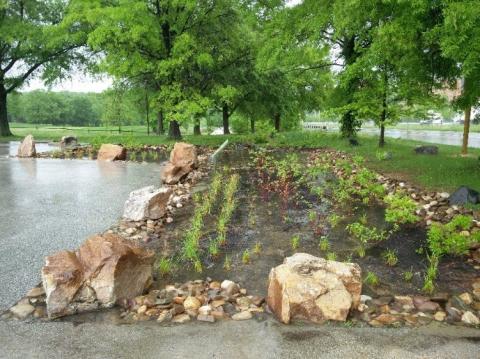Rain Gardens
What Is a Rain Garden?

A rain garden, also called a bioretention cell, is an engineered combination of specially selected plants, soils and mulch designed to collect, retain and cleanse rainwater that runs off impervious surfaces such as parking lots and rooftops. Physical, chemical and biological processes occur on the surface, in the root zone and throughout the soil profile. Shortly after a heavy rain, water stands in these rain gardens for several hours. Unlike traditional curbs and storm drains that quickly move stormwater off site, new practices, such as rain gardens, slow down stormwater so it can percolate into the soil, naturally filtering pollutants and recharging the groundwater. This is especially beneficial to the health of trees and streams during dry spells.
Rain Garden Research
Professor Allen P. Davis, Department of Civil and Environmental Engineering, is conducting research to measure the effectiveness of contaminant removal by rain gardens, focusing on nitrogen, phosphorus, zinc, copper and suspended solids. Several campus rain gardens have concrete channels and automated monitoring stations that measure water flow and pollutants. Each area is lined with plastic to ensure that all stormwater runoff can be measured. The findings of this research are helping us design even more effective small-scale water treatment methods. Bioretention sites were designed and installed at the campus in 2003 through a partnership with UMD Facilities Management and the Prince George's County Department of Environmental Resources under a U.S. Environmental Protection Agency grant for experimental technologies.
